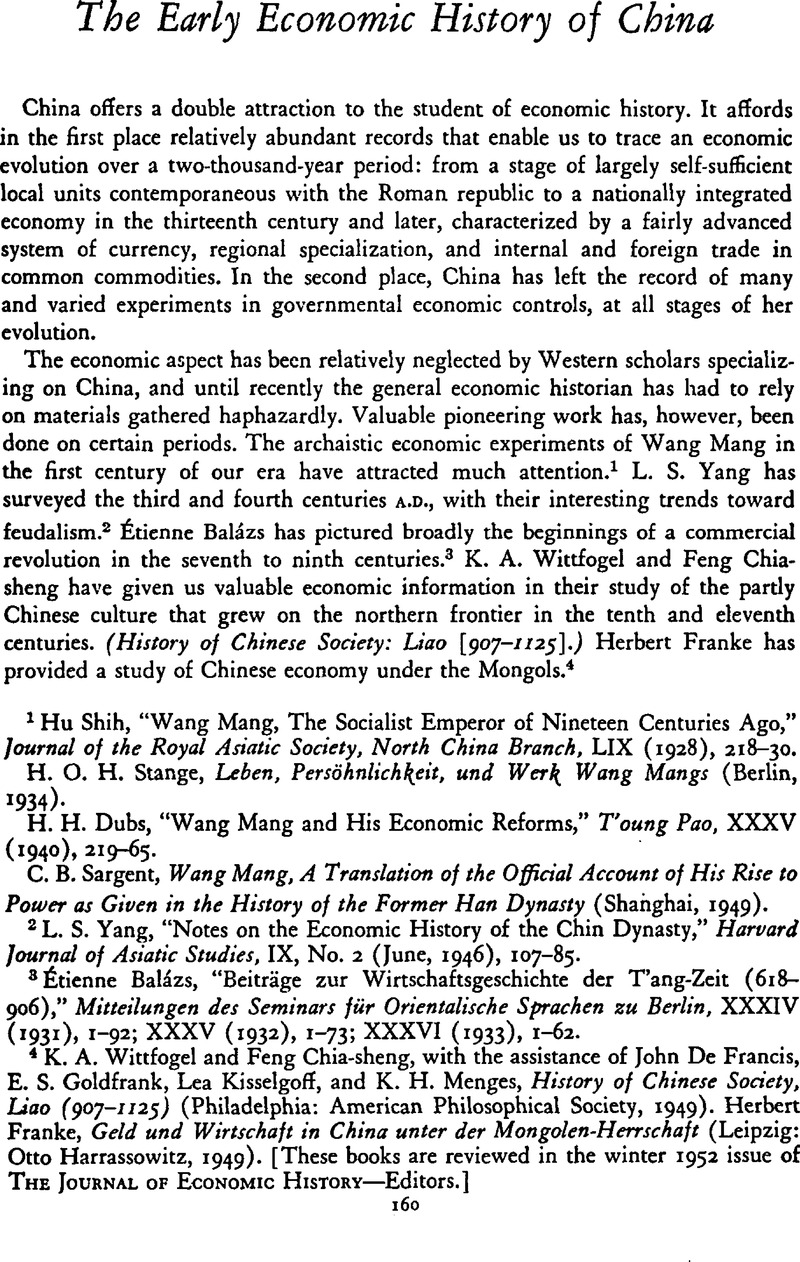No CrossRef data available.
Article contents
The Early Economic History of China
Published online by Cambridge University Press: 03 February 2011
Abstract

- Type
- Notes and Review Articles
- Information
- Copyright
- Copyright © The Economic History Association 1952
References
1 Shih, Hu, “Wang Mang, The Socialist Emperor of Nineteen Centuries Ago,’ Journal of the Royal Asiatic Society, North China Branch, LIX (1928), 218–30Google Scholar.
Stange, H. O. H., Leben, Persöhnlichkeit, und Werk Wang Mangs (Berlin, 1934)Google Scholar
Dubs, H. H., “Wang Mang and His Economic Reforms,” T'oung Pao, XXXV (1940), 219–65Google Scholar.
Sargent, C. B., Wang Mang, A Translation of the Official Account of His Rise to Power as Given in the History of the Former Han Dynasty (Shanghai, 1949)Google Scholar.
2 Yang, L. S., “Notes on the Economic History of the Chin Dynasty,” Harvard Journal of Asiatic Studies, IX, No. 2 (June, 1946), 107–85CrossRefGoogle Scholar.
3 Balázs, Étienne, “Beiträge zur Wirtschaftsgeschichte der T'ang-Zeit (618–906),” Mitteilungen des Seminars f¨r Orientalische Sprachen zu Berlin, XXXIV (1931), 1–92Google Scholar; XXXV (1932), 1–73; XXXVI (1933), 1–62.
4 Wittfogel, K. A. and Chia-sheng, Feng, with the assistance of John De Francis, E. S. Goldfrank, Lea Kisselgoff, and K. H. Menges, History of Chinese Society, Liao (907–1125) (Philadelphia: American Philosophical Society, 1949)Google Scholar. Herbert Franke, Geld und Wirtschaft in China unter der Mongolen-Herrschaft (Leipzig: Otto Harrassowitz, 1949). [These books are reviewed in the winter 1952 issue of The Journal Of Economic History—Editors.]
5 Swann, Nancy Lee, translator and annotator, Food and Money in Ancient China: The Earliest Economic History of China to A.D. 25, Han Shu 24, With Related Texts, Han Shu 91 and Shih-chi 129 (Princeton: Princeton University Press, 1950), pp. xiii + 482Google Scholar.
6 Gale, E. M., Discourses on Salt and Iron (Leiden, 1931)Google Scholar. Continued by Gale, Lin, and Boodberg in Journal of the Royal Asiatic Society, North China Branch, LXV (1934), 73–110Google Scholar.
7 Wilbur, C. M., Slavery in China During the Former Han Dynasty (Chicago, 1943CrossRefGoogle Scholar)
8 Blue, R. C., “The Argumentation of the Shih-huo Chih,” Harvard Journal of Asiatic Studies, XI, Nos. 1 and 2 (June, 1948), 1–118CrossRefGoogle Scholar.
8 Chavannes, Edouard, Les Mémoires Historiques de Se-ma Ts'ien, 5 vols. (Paris, 1895–1905)Google Scholar.
10 Dubs, H H, The History of the Former Han Dynasty by Pan Ku, 2 vols. (Baltimore, 1938 and 1944)Google Scholar.
11 Duyvendak, J. J. L., Review of Food and Money in Ancient China, T'oung Pao, XL, Livr. 1–3 (1950), 210–16Google Scholar.
Yang, L. S., “Notes on Dr. Swann's Food and Money in Ancient China,” Harvard Journal of Asiatic Studies, XIII, Nos. 3 and 4 (December, 1950), 524–57CrossRefGoogle Scholar.




